Why Do We Need Pebbles Under the Transformer?
Have you ever wondered why those large, humming transformers sit on beds of pebbles? It’s not just for looks – those small stones play a crucial role in transformer safety and efficiency.
Pebbles under transformers serve multiple purposes including oil spill containment, fire hazard mitigation, improved drainage, and easier maintenance. They act as a protective layer, enhancing safety and environmental protection while extending the transformer’s lifespan.

In my years of working with transformer installations, I’ve seen firsthand how these seemingly simple pebbles can make a world of difference. Let’s dive into the reasons why pebbles are an essential part of transformer setup.
Introduction: The Role of Pebbles in Transformer Installation – More Than Meets the Eye?
Have you ever walked past a transformer and noticed the bed of stones beneath it? Those aren’t just for decoration – they’re a critical component of the installation.
Pebbles in transformer installation play multiple roles including oil containment, fire prevention, drainage improvement, and maintenance facilitation. They form a crucial part of the transformer’s safety and operational efficiency system.
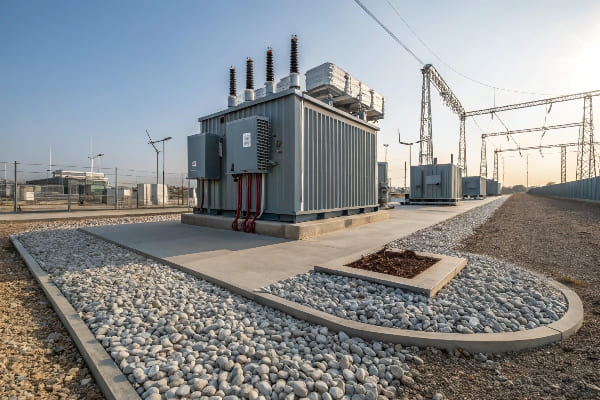
In my experience, the importance of these pebbles is often underestimated. Here’s why they’re so crucial:
Multifunctional Protection
-
Oil Containment:
- Pebbles create a permeable layer to catch oil leaks
- Prevents oil from spreading and contaminating the surrounding area
-
Fire Safety:
- Acts as a barrier between the transformer and the ground
- Helps prevent the spread of fire in case of a transformer failure
-
Drainage System:
- Allows water to drain away from the transformer base
- Prevents water accumulation which can lead to corrosion
Installation Considerations
| Aspect | Importance | Consideration |
|---|---|---|
| Pebble Size | Affects drainage and stability | Usually 20-40mm diameter |
| Layer Depth | Determines effectiveness | Typically 150-300mm deep |
| Material | Impacts durability and function | Often use river rocks or crushed stone |
Beyond Basic Function
Based on my observations, pebbles offer additional benefits:
-
Aesthetic Appeal:
- Provides a clean, organized look to the installation site
- Can be chosen to blend with surrounding landscaping
-
Pest Control:
- Discourages small animals from nesting near the transformer
- Reduces vegetation growth around the base
-
Thermal Management:
- Helps in heat dissipation from the transformer base
- Maintains a more stable ground temperature
I once worked on a project where the client wanted to skip the pebble layer to save costs. We installed the transformer directly on a concrete pad. Within a year, we faced issues with water pooling, oil staining, and even a minor fire incident. This experience reinforced the importance of proper pebble installation for me.
Remember, while pebbles might seem like a small detail, they play a significant role in the overall safety and efficiency of transformer installations. Proper selection and installation of this pebble layer can make a substantial difference in the long-term performance and maintenance of your transformer.
Preventing Oil Spills: How Pebbles Act as a Containment Layer?
Have you ever spilled cooking oil and watched it spread rapidly across your kitchen floor? Now imagine that on a much larger scale with transformer oil. That’s where pebbles come to the rescue.
Pebbles act as an effective oil containment layer under transformers by creating a permeable barrier. They allow oil to seep through while slowing its spread, making cleanup easier and preventing widespread soil contamination.
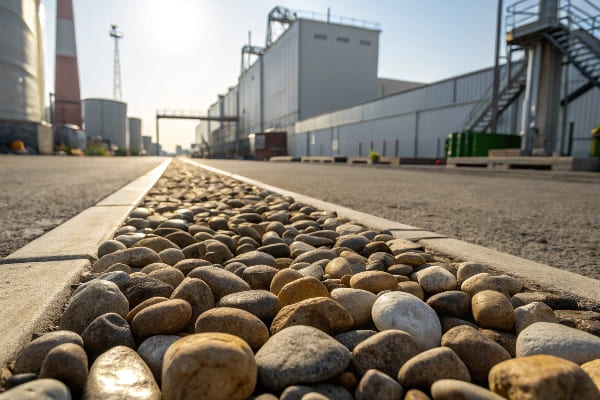
Throughout my career, I’ve seen how crucial this simple layer of stones can be in managing oil spills. Let’s dive into how they work:
Mechanism of Oil Containment
-
Permeability:
- Pebbles allow oil to pass through spaces between them
- Slows down the spread of oil compared to flat surfaces
-
Surface Area:
- Large surface area of pebbles catches and holds oil
- Reduces the amount of oil reaching the soil beneath
-
Filtration Effect:
- Acts as a basic filter, trapping larger oil particles
- Helps in separating oil from water in case of rain
Pebble Characteristics for Effective Containment
| Characteristic | Importance | Optimal Range |
|---|---|---|
| Size | Affects oil flow and retention | 20-40mm diameter |
| Shape | Impacts interlocking and stability | Rounded to sub-angular |
| Material | Determines durability and absorption | Non-porous, chemically inert |
Beyond Basic Containment
Based on my experience, the pebble layer offers additional benefits in oil spill management:
-
Heat Dissipation:
- Helps cool spilled oil, reducing fire risk
- Maintains lower ground temperature
-
Easy Cleanup:
- Contaminated pebbles can be easily removed and replaced
- Allows for targeted cleanup without extensive excavation
-
Visual Indicator:
- Oil on pebbles is easily visible during inspections
- Helps in early detection of small leaks
I once dealt with a transformer leak where the pebble layer contained over 100 gallons of oil. Without this layer, the oil would have spread widely, contaminating a large area of soil. Instead, we were able to contain and clean up the spill with minimal environmental impact.
Maintenance Considerations
-
Regular Inspections:
- Check pebble layer for oil stains or discoloration
- Ensure proper depth and coverage is maintained
-
Periodic Replacement:
- Replace heavily contaminated sections of pebbles
- Refresh the layer every few years to maintain effectiveness
-
Drainage Checks:
- Ensure the pebble layer isn’t clogged with debris
- Maintain proper slope for effective oil and water drainage
Remember, while pebbles are excellent for initial containment, they’re not a substitute for proper transformer maintenance and leak prevention. Regular transformer inspections and prompt addressing of any leaks are still crucial for environmental protection.
Enhancing Safety: Pebbles and Fire Hazard Mitigation?
Have you ever wondered why transformers don’t turn into infernos when they fail? The answer might be right under your feet – in the form of pebbles.
Pebbles play a crucial role in fire hazard mitigation for transformers. They create a non-combustible barrier, help dissipate heat, and prevent the spread of burning oil. This simple layer of stones can be the difference between a contained incident and a catastrophic fire.
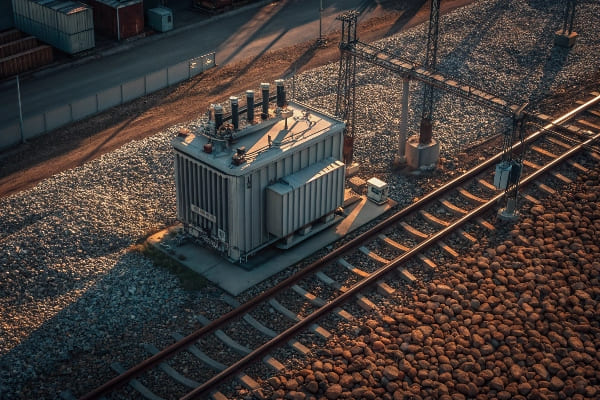
In my years of working with transformer installations, I’ve seen how effective pebbles can be in preventing and containing fires. Here’s what you need to know:
Fire Mitigation Mechanisms
-
Non-Combustible Barrier:
- Pebbles don’t burn, creating a fireproof layer
- Prevents direct contact between burning oil and the ground
-
Heat Dissipation:
- Stones absorb and distribute heat
- Helps cool burning oil, potentially extinguishing small fires
-
Oil Spread Prevention:
- Slows down the spread of burning oil
- Contains the fire within a smaller area
Pebble Characteristics for Fire Safety
| Property | Importance | Ideal Characteristics |
|---|---|---|
| Material | Determines heat resistance | Igneous rocks like granite |
| Size | Affects heat absorption and distribution | 20-40mm for optimal performance |
| Depth | Influences effectiveness of fire barrier | Minimum 150mm, ideally 300mm |
Beyond Basic Fire Prevention
Based on my experience, the pebble layer offers additional safety benefits:
-
Electrical Insulation:
- Provides an extra layer of insulation from the ground
- Reduces risk of electrical faults during failures
-
Explosion Mitigation:
- Absorbs and dissipates energy from potential explosions
- Reduces the risk of projectiles in case of catastrophic failure
-
Smoke Reduction:
- Limits the amount of soil that can burn with the oil
- Potentially reduces toxic smoke in case of fire
I once witnessed a transformer failure that could have been catastrophic. The pebble bed contained the burning oil, preventing it from spreading to nearby equipment. This containment gave the fire suppression systems time to activate and extinguish the fire before it could escalate.
Maintenance for Fire Safety
-
Regular Cleaning:
- Remove debris and vegetation from the pebble bed
- Ensure no combustible materials accumulate
-
Inspection of Pebble Layer:
- Check for proper depth and coverage
- Replace any areas that show signs of contamination or degradation
-
Integration with Fire Systems:
- Ensure pebble bed design complements other fire prevention measures
- Consider adding fire-resistant materials or coatings to enhance protection
Remember, while pebbles are an excellent passive fire prevention measure, they should be part of a comprehensive fire safety strategy. Proper transformer maintenance, regular inspections, and active fire suppression systems are all crucial components of transformer fire safety.
Improving Drainage: Why Pebbles Are Essential for Water Management?
Ever noticed how water seems to disappear quickly around a well-maintained transformer? That’s not magic – it’s the power of pebbles at work.
Pebbles are essential for water management around transformers as they provide excellent drainage. They prevent water accumulation, reduce the risk of flooding, and help maintain the stability of the transformer foundation. Proper drainage is crucial for the longevity and safe operation of the transformer.
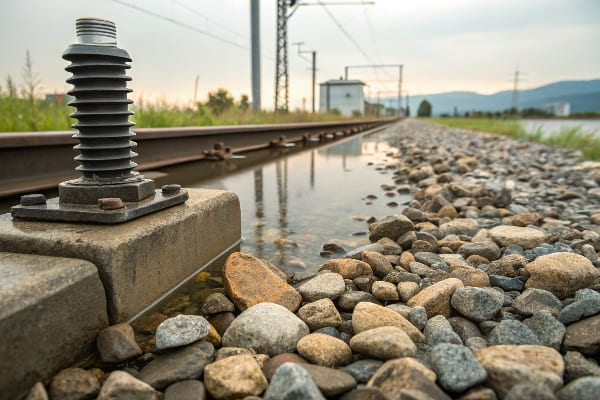
Throughout my career, I’ve seen how effective drainage can make or break a transformer installation. Here’s why pebbles are so important:
Drainage Mechanisms
-
Permeability:
- Spaces between pebbles allow water to flow freely
- Prevents water from pooling on the surface
-
Filtration:
- Pebbles act as a natural filter, trapping sediments
- Helps maintain clean drainage paths
-
Erosion Control:
- Reduces water flow velocity
- Prevents soil erosion around the transformer base
Pebble Characteristics for Optimal Drainage
| Feature | Impact | Ideal Properties |
|---|---|---|
| Size | Affects water flow rate | 20-40mm for balance of flow and stability |
| Shape | Influences packing and flow | Rounded to sub-angular for optimal drainage |
| Gradation | Determines void space | Well-graded mix for efficient drainage |
Beyond Basic Drainage
Based on my observations, proper drainage through pebbles offers additional benefits:
-
Temperature Regulation:
- Helps maintain consistent ground temperature
- Reduces thermal stress on transformer foundation
-
Frost Heave Prevention:
- Allows water to drain, reducing frost heave risk in cold climates
- Maintains stability of the transformer pad
-
Groundwater Protection:
- Filters out oil and contaminants from rainwater
- Helps protect groundwater quality
I once worked on a transformer installation in a flood-prone area. By implementing a carefully designed pebble drainage system, we were able to keep the transformer operational even during heavy rains that flooded surrounding areas. This experience highlighted the critical role of proper drainage in ensuring transformer reliability.
Maintenance for Effective Drainage
-
Regular Cleaning:
- Remove debris that can clog spaces between pebbles
- Prevent vegetation growth that can impede drainage
-
Periodic Inspection:
- Check for areas of settlement or displacement
- Ensure proper slope is maintained for effective drainage
-
Drainage Path Maintenance:
- Keep drainage outlets clear and functional
- Ensure water has a clear path away from the transformer
Remember, while pebbles provide excellent drainage, they’re part of a larger water management system. Proper site grading, strategic placement of drainage pipes, and regular maintenance are all crucial for effective water management around transformers.
Maintenance Benefits: Easy Cleanup and Reduced Contamination Risks?
Ever wondered why some transformer sites always look clean and well-maintained? The secret might be right under the transformer – in the form of pebbles.
Pebbles offer significant maintenance benefits for transformer installations. They facilitate easy cleanup of oil spills, reduce soil contamination risks, and simplify routine maintenance tasks. This not only improves site aesthetics but also enhances overall safety and environmental protection.
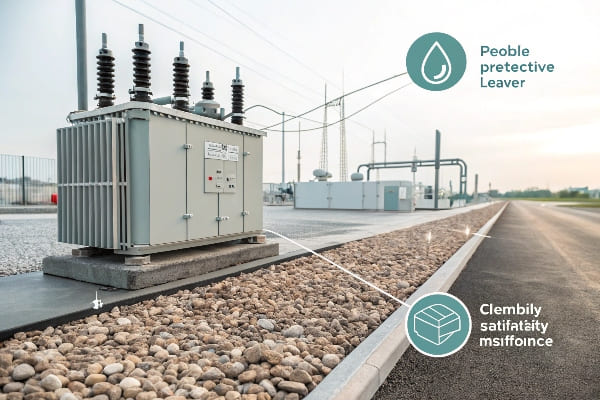
In my years of experience with transformer maintenance, I’ve come to appreciate the simplicity and effectiveness of pebble beds. Here’s why they’re a maintenance dream:
Cleanup and Contamination Control
-
Oil Spill Management:
- Pebbles contain and slow oil spills
- Allow for easy removal of contaminated stones
-
Soil Protection:
- Act as a barrier between transformer and soil
- Reduce risk of long-term soil contamination
-
Visual Inspection:
- Oil stains are easily visible on pebbles
- Facilitates early detection of leaks
Maintenance Task Simplification
| Task | How Pebbles Help | Benefit |
|---|---|---|
| Routine Inspections | Provide clear, stable surface | Easier access and safer footing |
| Equipment Access | Can be easily moved and replaced | Simplifies access to transformer base |
| Vegetation Control | Inhibit plant growth | Reduces need for frequent landscaping |
Beyond Basic Maintenance
Based on my experience, pebble beds offer additional maintenance advantages:
-
Thermal Management:
- Help dissipate heat from the transformer
- Reduce thermal stress on foundation
-
Pest Control:
- Discourage burrowing animals
- Reduce habitat for insects near the transformer
-
Moisture Management:
- Prevent water accumulation
- Reduce corrosion risk for transformer components
I once dealt with a transformer site that didn’t use pebbles. Every maintenance visit was a challenge – muddy conditions, difficult access, and constant worry about soil contamination. After we retrofitted the site with a proper pebble bed, maintenance became significantly easier and more effective.
Best Practices for Pebble Bed Maintenance
-
Regular Raking:
- Maintain even distribution of pebbles
- Remove any accumulated debris
-
Periodic Replacement:
- Replace heavily contaminated sections
- Refresh the entire bed every few years
-
Drainage Checks:
- Ensure pebbles aren’t impeding proper drainage
- Clear any clogged areas
Remember, while pebbles greatly simplify maintenance, they’re not a set-and-forget solution. Regular inspection and maintenance of the pebble bed itself are crucial for it to continue providing these benefits. A well-maintained pebble bed not only makes your job easier but also contributes significantly to the overall safety and longevity of the transformer installation.
Environmental Considerations: Eco-Friendly Advantages of Using Pebbles?
Ever thought about how something as simple as pebbles could be environmentally friendly? When it comes to transformer installations, these little stones pack a big eco-punch.
Pebbles offer several eco-friendly advantages in transformer installations. They help prevent soil and groundwater contamination, reduce the need for chemical treatments, and are a natural, reusable material. Their use aligns with sustainable practices in electrical infrastructure development.
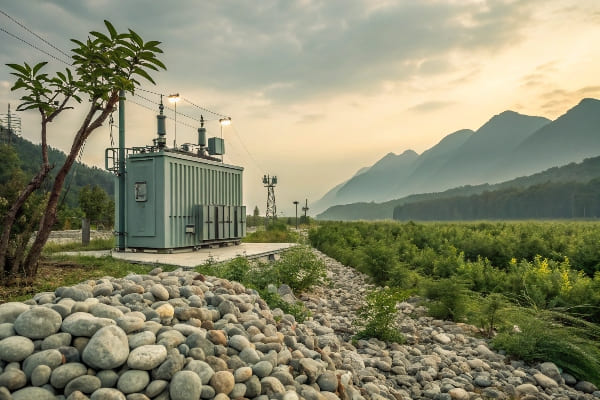
Throughout my career, I’ve seen a growing emphasis on environmental considerations in transformer design and installation. Here’s why pebbles are a great choice for the eco-conscious engineer:
Environmental Protection Features
-
Soil Contamination Prevention:
- Act as a barrier between transformer and soil
- Contain oil spills, preventing widespread contamination
-
Groundwater Protection:
- Filter out contaminants from rainwater
- Reduce risk of oil seeping into groundwater
-
Natural Material Use:
- Pebbles are typically sourced locally
- Minimal processing required, reducing carbon footprint
Eco-Friendly Aspects of Pebbles
| Aspect | Environmental Benefit | Comparison to Alternatives |
|---|---|---|
| Recyclability | Can be cleaned and reused | Better than concrete or asphalt |
| Heat Absorption | Reduces urban heat island effect | More effective than bare soil |
| Biodiversity | Can support small ecosystems | Better than artificial surfaces |
Beyond Basic Environmental Protection
Based on my observations, pebble beds offer additional ecological benefits:
-
Reduced Chemical Use:
- Minimize need for herbicides around transformer
- Less reliance on chemical cleaners for maintenance
-
Natural Drainage:
- Promote natural water filtration
- Reduce runoff and erosion issues
-
Habitat Creation:
- Can provide microhabitats for small organisms
- Contribute to local biodiversity in urban areas
I once worked on a project where we replaced a concrete pad with a pebble bed around a transformer in an environmentally sensitive area. Not only did it improve the site’s aesthetics, but we also noticed a significant reduction in chemical use for weed control and a marked improvement in local drainage. The local environmental agency commended our approach, highlighting the positive impact on the surrounding ecosystem.
Sustainable Practices in Pebble Use
-
Local Sourcing:
- Use pebbles from nearby quarries or riverbeds
- Reduce transportation-related carbon emissions
-
Proper Sizing and Selection:
- Choose appropriate size and type for optimal performance
- Minimize need for frequent replacement
-
Integration with Green Infrastructure:
- Combine pebble beds with other eco-friendly landscaping
- Create cohesive, sustainable site designs
Long-Term Environmental Benefits
-
Reduced Soil Disturbance:
- Pebble beds require less frequent replacement than other surfaces
- Minimize soil disruption during maintenance activities
-
Heat Island Mitigation:
- Pebbles reflect more sunlight than dark surfaces
- Help reduce localized temperature increases in urban areas
-
Adaptability to Climate Change:
- Provide better drainage in areas facing increased rainfall
- Offer more resilience to extreme weather events
Remember, while pebbles offer significant environmental advantages, their benefits are maximized when integrated into a comprehensive eco-friendly design approach. Combining pebble beds with other sustainable practices can create transformer installations that not only function efficiently but also contribute positively to their surrounding environment.
Common Mistakes to Avoid When Installing Pebbles Under Transformers: What Not to Do?
Have you ever heard the saying, "The devil is in the details"? When it comes to installing pebbles under transformers, this couldn’t be more true. Let’s explore some common pitfalls to avoid.
Common mistakes in pebble installation under transformers include using incorrect pebble size, inadequate depth, poor drainage design, and neglecting proper foundation preparation. These errors can compromise the effectiveness of the pebble layer, potentially leading to safety hazards and reduced transformer performance.
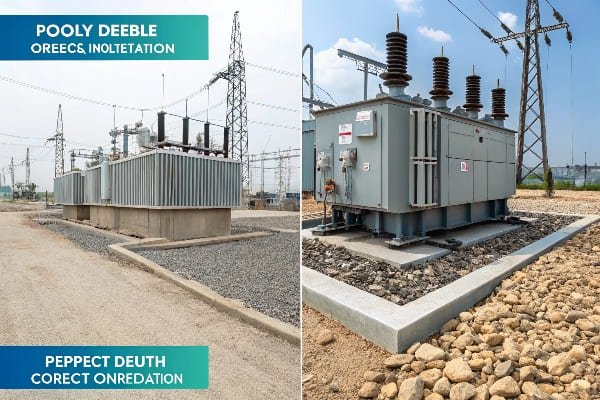
In my years of overseeing transformer installations, I’ve seen my fair share of pebble-related mishaps. Here’s what you need to watch out for:
Critical Installation Errors
-
Incorrect Pebble Size:
- Using pebbles too small can lead to compaction issues
- Oversized pebbles may create unstable surfaces
-
Inadequate Layer Depth:
- Insufficient depth reduces effectiveness in oil containment
- Too shallow to provide proper drainage
-
Poor Drainage Design:
- Failing to consider overall site drainage
- Neglecting to create proper slopes for water runoff
Common Mistakes and Their Consequences
| Mistake | Consequence | Correct Approach |
|---|---|---|
| Using mixed sizes | Uneven settling, poor drainage | Use uniform size (20-40mm typically) |
| Neglecting underlayment | Soil contamination, pebble sinking | Install geotextile fabric beneath pebbles |
| Overfilling | Pebbles scattered, trip hazard | Maintain level slightly below transformer base |
Beyond Basic Installation Errors
Based on my experience, here are some less obvious but equally important considerations:
-
Ignoring Local Regulations:
- Failing to comply with specific local requirements
- Overlooking environmental regulations for pebble use
-
Neglecting Maintenance Access:
- Not planning for easy access for maintenance tasks
- Failing to consider equipment needed for pebble replacement
-
Underestimating Quantity Needed:
- Not accounting for settling and displacement over time
- Insufficient supply for proper coverage and depth
I once encountered a site where the installer used river rocks instead of proper crushed stone. While it looked aesthetically pleasing, the smooth surfaces of the river rocks created a unstable foundation that shifted under foot traffic, posing a safety hazard during maintenance. We had to completely redo the installation, causing significant delays and added costs.
Best Practices to Ensure Proper Installation
-
Thorough Site Preparation:
- Ensure proper grading and compaction of the base
- Install appropriate underlayment or geotextile fabric
-
Careful Material Selection:
- Choose pebbles that meet size and composition requirements
- Consider local climate and environmental factors
-
Proper Layering Technique:
- Install pebbles in layers, compacting each layer
- Maintain consistent depth across the installation area
-
Integration with Overall Site Design:
- Ensure pebble bed complements other site features
- Consider future expansion or equipment upgrades
Remember, while installing pebbles might seem straightforward, attention to detail is crucial. A properly installed pebble bed not only enhances the safety and performance of your transformer but also contributes to the overall reliability of your electrical infrastructure. Taking the time to do it right the first time can save you from costly corrections and potential hazards down the line.
Conclusion
Pebbles under transformers are crucial for safety, maintenance, and environmental protection. They provide oil containment, fire mitigation, improved drainage, and eco-friendly benefits. Proper installation and maintenance of pebble beds are essential for optimal transformer performance and longevity.
Free CHBEB Transformer Catalog Download
Get the full range of CHBEB transformers in one catalog.
Includes oil-immersed, dry-type, pad-mounted, and custom solutions.
Quick Message
Request A free quote
We'd like to work with you
- +86 15558785111
- [email protected]
- +86 15558785111
What We Do
CHINA BEI ER BIAN (CHBEB) GROUP, with 218 million in registered capital, originated from Beijing Beierbian Transformer Group. Headquartered in Beijing for R&D, it operates major production bases in Nanjing and Yueqing, producing high-quality products.
Latest Product
address
BeiJing
No 3,RongJing East Road,BeiJing Economic Technological Development Area,BeiJing,China
JiangSu
No 7️Xiangfeng Road,Jiangning,NanJing,JiangSu,China
WenZhou
No.211, Wei 16 Road, Industrial Zone, Yueqing, Wenzhou, Zhejiang, China.
XiangYang Industrial Zone ,YueQing,WenZhou,ZheJiang,China
contact us
- [email protected]
- +86 13057780111
- +86 13057780111
- +86 15558785111
Copyright © Bei Er Bian Group


